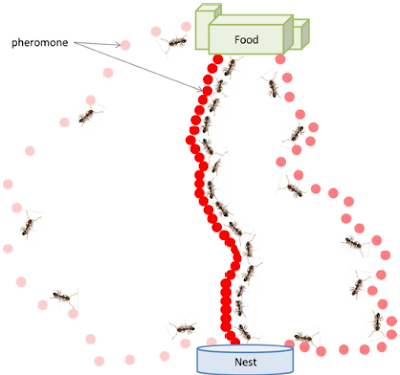The science first ...
Stigmergy is a term for individuals collaborating or coordinating through the effect of their actions on the environment. It comes from the study of animal populations which demonstrate sophisticated emergent behaviours without any obvious control structure or even direct communication.
If that sounds too abstract, think about wasp, ant, or termite colonies and the level of organisation suggested by their complex nest-building, foraging, feeding, and breeding patterns.
You've probably heard about scent signals. Stigmergy observes that an individual will mark the path to a food source and that this influences the behaviour of other members of the community. They in turn also mark the path, reinforcing the signal and bringing still others to it.
If there are alternative routes to the food then the one which conveys most benefit, perhaps by requiring less energy to reach, will tend to get reinforced more.
It can be instructive to identify a couple of subtypes of stimergy:
-
quantitative: the volume of some material governs behaviour. Termites
collect mud balls until an amount-based trigger is reached and columns can be built. This kind of feedback mechanism can be both positive (reinforcing
behaviour) and negative (inhibiting behaviour).
-
qualitative: the arrangement or type governs behaviour. Wasps build nests of hexagonal cells by preferring to add a
cell where there are already most existing walls. This keeps the overall
shape compact rather than being, say, a long string of single cells.
And so what?
For me, aside from the purely academic fascination, I find this interesting because I work as an individual in a collective and often wonder how I can help to reduce friction in our activities — where it makes sense to want reduced friction, that is.
By friction I mean things that get in the way of doing the interesting stuff.
My company is in a regulated industry and there are procedural requirements around our work, including the need for audit trails. I have made an effort to introduce lightweight, consumable, but sufficient reminders of process at the point where it needs to be completed.
To give just one example, our PRs are prepopulated with this template for the requestor to fill in:
We bring context, learning, and Compliance to our work by **always** giving this information:
### Tickets (this PR, related)
### What, why, how?
### Dependencies
### Testing (unit, you, others)We arrived at this through conversation and experimentation. It reminds us to include what needs to be included and consider what needs to be considered without becoming a mindless checkbox chore of the kind that everybody ultimately skips.
In an analogy with stimergy, that's probably qualitative. We have arranged for the shape of the task to be conducive to the kind of outcome we want to encourage.
I have experience of activities that feel somewhat like quantitive stimergy too. A recent example could be the format for test notes that serves me well that I use reliably and regularly. Other quality engineers in the company saw it, and my dedication to it, and the benefit I get from it, and adopted it too. Recently I also see developers using it for exploratory investigation and spikes as we plan a new service. The weight of its usage encourages more usage.
In A Brief History of Stigmergy, Guy Theraulaz and Eric Bonabeau, note that this signal-directed activity can go very wrong if the signal appears outside of an appropriate context. Again, this has analogues in the workplace; who hasn't followed a process without understanding it, unsure of whether they're doing the right thing in the right place at the right time?
Of course, insects didn't negotiate the format of any signals they react to and my colleagues are making conscious choices about whether and how to document their work. But I like the idea that the behavioural clues we leave in our environment are a kind of external memory and seeds of a shared culture and I wonder whether we can look to deliberately exploit them more to incentivise the behaviours we prefer.
Image: Samiagamoura via Wikimedia
Highlighting: Pinetools
